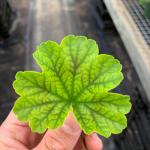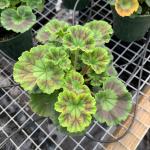Symptoms of nutrient imbalance were observed in geraniums in the UMass Extension Plant Diagnostic Lab this week. Leaves showed distinct interveinal chlorosis, with younger leaves most severely affected. Soil testing revealed a pH of 6.0 and electroconductivity (EC) of 0.58 mS/cm (1:2 method). Although the optimal pH range for geraniums is 6.0-6.5, the EC is below the optimal range of 0.75-1.25 mS/cm, indicating that fertility is low. When the plants were removed from their pots, root rot was discovered, and Pythium was detected in the roots on microscopic examination. In addition, fungus gnats were observed on the surface of the medium. It is likely that all three of these issues contributed to symptom development.
Pythium species tend to have broad host ranges and all greenhouse crops are susceptible to infection under the right circumstances, though some species and cultivars are more susceptible than others. The pathogen is especially troublesome in overwatered or poorly drained growing media, in situations where fertility is high, and in hydroponic systems. It has been especially easy to overwater and/or overfertilize under the predominantly cool and overcast conditions this spring.
Symptoms of Pythium root rot include stunting, wilting, yellowed leaves, plant collapse, and death. Because Pythium impairs root function, symptoms of nutrient deficiency may also be observed. It is always advisable to inspect the root system of plants with these symptoms. Infected roots will be brown and soft, sometimes with a “rat-tail” appearance as the outer cortex of the root sloughs off, leaving the vascular cylinder behind. Some species cause severe disease with a rapid onset, while others cause a chronic infection that progresses more slowly. Disease severity is also dependent on temperature, as the optimal range for growth and infection varies among species.
Sanitation is critical for successful Pythium management. Do not reuse potting media. Avoid re-using pots if possible; if pots are to be re-used, they must be thoroughly cleaned, and all organic matter removed before treating with a disinfectant such as quaternary ammonium or 10% bleach. Similarly, all organic matter and biofilms must be removed from hydroponic systems prior to disinfection. Pythium also thrives when nitrogen is abundant, so avoid overfertilization. Control fungus gnats: feeding injury caused by larvae predispose plants to Pythium infection, and adults can carry the pathogen from plant to plant.
Several conventional and organic products are labeled for Pythium management and for fungus gnats: for full lists, please see the New England Greenhouse Floriculture Guide. In addition, many growers are using beneficial nematodes to manage fungus gnats: see our update from April 4th, 2022 for more information.
- Dr. Angela Madeiras, Extension Educator & Diagnostician, UMass Extension Plant Diagnostic Lab



